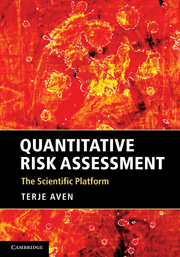Book contents
- Frontmatter
- Contents
- Preface
- Acknowledgments
- 1 Introduction to risk management and risk assessments. Challenges
- 2 Concepts and perspectives on risk
- 3 Science and scientific requirements
- 4 Introduction to case studies
- 5 Risk assessment when the objective is accurate risk estimation
- 6 Risk assessment when the objective is uncertainty descriptions
- 7 Risk management and communication issues
- 8 Towards a holistic scientific approach to risk assessment
- 9 Conclusions
- Appendix A Introduction to probability theory and statistical analysis
- Appendix B Terminology
- References
- Index
8 - Towards a holistic scientific approach to risk assessment
Published online by Cambridge University Press: 05 June 2012
- Frontmatter
- Contents
- Preface
- Acknowledgments
- 1 Introduction to risk management and risk assessments. Challenges
- 2 Concepts and perspectives on risk
- 3 Science and scientific requirements
- 4 Introduction to case studies
- 5 Risk assessment when the objective is accurate risk estimation
- 6 Risk assessment when the objective is uncertainty descriptions
- 7 Risk management and communication issues
- 8 Towards a holistic scientific approach to risk assessment
- 9 Conclusions
- Appendix A Introduction to probability theory and statistical analysis
- Appendix B Terminology
- References
- Index
Summary
In Chapters 5–7 we have seen how risk assessments and risk management are influenced by the risk perspectives. Now we would like to go one step further, to provide guidance on what should be the preferred approach to risk. The basis for the guidance is the discussions in the previous chapters. Firstly we need to clarify what we mean by risk. A number of definitions and interpretations of the risk concept exist as discussed in Chapter 2. Many of these are probability-based. Below (Section 8.1) we present and discuss a structure for characterising the definitions, which is founded on a clear distinction between (Aven, 2010f)
(a) risk as a concept based on events, consequences and uncertainties;
(b) risk as a modelled, quantitative concept; and
(c) risk descriptions.
The discussion leads to an approach for conceptualising and assessing risk, which is based on risk defined by (a), i.e. is founded on the (A,C,U) risk perspective, and the probability-based definitions of risk can be viewed as model parameters and/or risk descriptions. The approach provides clear guidance on how to think when conceptualising and assessing risk in practice.
Next in this chapter (Section 8.2) we present and discuss a general model-based framework for risk assessments. Starting from an industry guide to quantitative uncertainty analysis and management, clarifications and simplifications are made to ensure consistency with the (A,C,U) risk perspective. Some simple examples are included to motivate and explain the basic ideas of the framework.
- Type
- Chapter
- Information
- Quantitative Risk AssessmentThe Scientific Platform, pp. 138 - 173Publisher: Cambridge University PressPrint publication year: 2011

